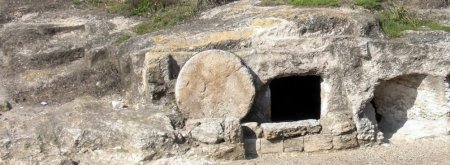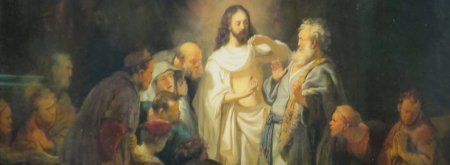The Resurrection
If Jesus Christ was raised from the dead, never to die again, he is instantly marked out as being distinct from every other person in history. He would be unique. There would be something dramatically different about him. The only question remaining would relate to the nature of his uniqueness – a question which Christian theology has answered in the doctrine of the incarnation. Yet the apologist will be aware that the resurrection of Christ proves a major stumbling block to many people.[1] The reasons for this centre upon three issues: the improbability of the event, the unreliability of the New Testament witnesses to the event, and its irrelevance to life. We shall explore some of these issues here.
The New Testament is permeated by the resurrection of Jesus of Nazareth. The consequences of this event, both for the personal experience of the first Christians and for their understanding of the understanding of the identity and significance of Jesus himself, dominate the horizons of the New Testament writers. It was on the basis of their firm belief that the one who was crucified had been raised by God from the dead, that the astonishing developments in the perceived status and identity of Jesus took place. The cross was interpreted from the standpoint of the resurrection, and Jesus’ teaching was accorded reverence on account of who the resurrection disclosed him to be. Jesus was worshipped and adored as the living Lord, who would come again – and not merely revered as a dead, super rabbi. The tendency to ‘think of Jesus Christ as of God’ (2 Clement 1:1) is already evident within the New Testament. It cannot be emphasized too strongly that the most important developments in the Christian understanding of the identity and significance of Jesus Christ took place, not during the patristic period on account of the questionable influence of Greek metaphysics, but within twenty years of the crucifixion itself.
Of course, modern critics of the resurrection argue, it was easy for the first Christians to believe in the resurrection of Jesus. After all, belief in resurrections was a commonplace at the time. The first Christians may have jumped to the conclusion that Jesus was raised from the dead, when something rather different actually happened. Although the crude charges of yesteryear (for example, that the disciples stole the corpse of Jesus from its tomb, or that they were the victims of mass hysteria) are still occasionally encountered, they have generally been superseded by more subtle theories. Thus, to note the most important, the resurrection was really a symbolic event, which the first Christians confused with an historical event on account of their uncritical presuppositions.
In response to this, however, it may be pointed out that neither of the two general beliefs of the time bear any resemblance to the resurrection of Jesus. The Sadducees denied the idea of a resurrection altogether (a fact which Paul was able to exploit at an awkward moment: Acts 23:6–8) while the majority expectation was of a general resurrection on the last day, at the end of history itself. The sheer oddness of the Christian proclamation of the resurrection of Jesus in human history, at a definite time and place, is all too easily overlooked by modern critics, even though it was obvious at the time. The unthinkable appeared to have happened, and for that very reason demanded careful attention. Far from merely fitting into the popular expectation of the pattern of resurrection, what happened to Jesus actually contradicted it. The sheer novelty of the Christian position at the time has been obscured by two thousand years' experience of the Christian understanding of the resurrection – yet at the time it was wild: unorthodox and radical.
To dismiss the Christian understanding of the resurrection of Jesus because it allegedly conformed to contemporary expectations is clearly unacceptable. The idea of the resurrection Jesus being explicable as some sort of wish-fulfilment on the part of the disciples also strains the imagination somewhat. Why should the disciples have responded to the catastrophe of Jesus death by making the hitherto unprecedented suggestion that he had been raised from the dead? The history of Israel is littered with the corpses of pious Jewish martyrs, none of whom was ever thought of as having been raised from the dead in such a manner.
The second attack on the historicity of the resurrection Jesus mounted in recent years is based upon the parallels between pagan myths of dying and rising gods and the resurrection of Jesus. In the first part of the present century, a substantial number of scholarly works appeared drawing attention to the pagan and gnostic myths. Perhaps J.G. Frazer's Adonis, Attis, Osiris is the most famous of these in the English-speaking world. It was argued that the New Testament writers were simply reproducing this myth, which was part of the intellectual furniture of the ancient world. Rudolf Bultmann was among many scholars of the period who argued for such influence (deriving from the Mandaeans) upon the resurrection accounts and beliefs of the New Testament, and then proceeded to take the logically questionable step of arguing that such parallels discredited the historicity of the resurrection of Jesus.
Since then, however, scholarship has moved on considerably. The parallels between the pagan myths of dying and rising gods and the New Testament accounts of the resurrection of Jesus are now regarded as remote, to say the least.[2] For instance, the New Testament documents with some care give the place and the date of both the death and the resurrection of Jesus, as well as identifying the witnesses to both. The contrast with the ahistorical narrative form of mythology is striking. Furthermore, there are no known instances of this myth being applied to any specific historical figure in pagan literature, so that the New Testament writers would have given a stunningly original twist to this mythology. It is at this point that the wisdom of C.S. Lewis – who actually knew something about myths – must be acknowledged.
Lewis realized that the New Testament accounts of the resurrection of Jesus bore no relation to real mythology, despite the claims of some theologians who had dabbled in the field. Perhaps most important, however, was his realization that the gnostic redeemer myths – which the New Testament writers allegedly took over and applied to Jesus – were to be dated from later than the New Testament itself. If anyone borrowed any ideas from anyone, it seems it was the gnostics who took up Christian ideas.
The challenge posed to the historicity of the resurrection by these theories has thus passed into textbooks of the history of ideas. But an important point must be made before we proceed any further. We have seen how allegedly responsible academic scholarship, regarded as competent in its own day, was seen to pose a serious challenge to a central aspect of the Christian faith. It was taken seriously by theologians and popular religious writers. Yet the sheer provisionality of scholarship seems to have been ignored. Scholarship proceeds by evaluation of evidence and hypotheses, a process which takes decades, in which what one generation took as self-evident is often later demonstrated to be wrong. The fate of the resurrection myth is a case in point: in 1920, it was treated virtually as an established fact of serious and responsible scholarship; three quarters of a century later, it is regarded as an interesting, if now discredited, idea.
How many more such theories, which now seem persuasive and to pose a challenge to the Christian faith, will be treated as obsolete in fifty years’ time? Christianity can hardly be expected to abandon its proclamation of the risen Christ as Saviour and Lord on such flimsy grounds. Furthermore, as anyone who works in the field of the history of ideas knows, it is remarkable how rapidly the assured presuppositions of one generation are abandoned by another! Christianity has a duty to speak for two thousand years of history, as well as for an untold period in the future, in refusing to allow the short-term preoccupations of modernity to dictate its character for posterity.
A third line of criticism of the historicity of the resurrection is due to the German sociologist Ernst Troeltsch, who argued that, as dead men don't rise, Jesus couldn't have risen. The basic principle underlying this objection goes back to David Hume, and concerns the need for present-day analogues for historical events. Before accepting that an event took place in the past, we need to be persuaded that it still takes place in the present. Troeltsch asserted that since we have no contemporary experience of the resurrection of a dead human being, we have reason for supposing that no dead man has ever been raised.
Of course, as Christianity has insisted that the resurrection of Jesus was a unique historical event, the absence of present-day analogues is only to be expected. If people were raised from the dead on a regular basis, there would be no difficulty in accepting that Jesus Christ had been thus raised. But it would not stand out. It would not be different. It would not say anything, either about the identity of Jesus himself, or about the God who chose to raise him in this way. The resurrection was taken so seriously because it was realized that it was totally out of the ordinary, unique in the proper sense of the word.
Nevertheless, a more sophisticated reply to this line of criticism is needed. The most vigorous response to Troeltsch’s criticism has been made by Wolfhart Pannenberg, who pointed out that Troeltsch had adopted a remarkably dogmatic view of reality, based upon questionable metaphysical presuppositions, effectively dictating what could and could not have happened in history on the basis of his preconceived views. Troeltsch, Pannenberg argued, had already laid down in advance that the resurrection could not happen. The argument seemed to move as follows:
a. Dead people do not rise from the dead.
b. Therefore Jesus Christ did not rise from the dead.
c. End of discussion.
But this is unacceptably superficial. The philosophical question of induction, noted earlier, does not allow the conclusion to be drawn from the premise. Observation does not determine fixed laws, which may be used to determine whether something did or did not happen in the past. It merely establishes the probability of events of a certain type.
For Pannenberg, the decisive factor in determining what happened on the first Easter Day is the evidence contained in the New Testament, and not dogmatic and provisional scholarly theories about the nature of reality. How, asks Pannenberg, are we to account for the New Testament evidence? What is its most probable explanation? The historical evidence liberates us from the dogmatic metaphysical presuppositions about what can and what can't have happened in history that underlie Troeltsch’s critique of the resurrection, and allows us to return to the Jesus of history. For Pannenberg, the resurrection of Jesus is the most probable and plausible explanation of the historical evidence. Perhaps it lacks the absolute certainty which the more fundamentalist of metaphysicians seem to demand – but, as Bishop Butler so carefully demonstrated in his Analogy of Religion, probability is the law of religious life, whether orthodox or deist.



